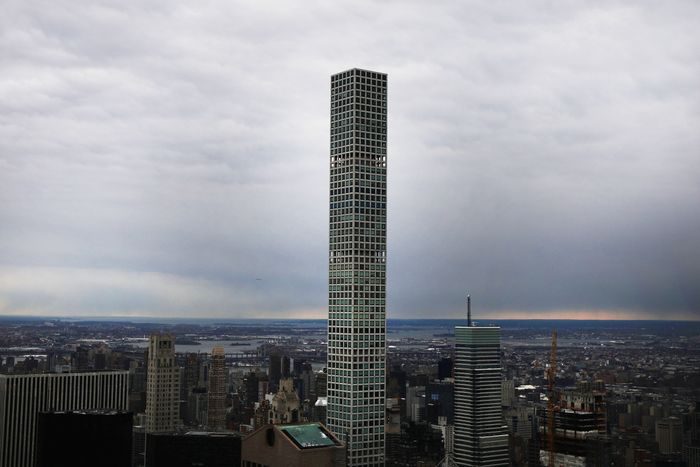
When the New York Times published its searching, empathetic investigation into the struggles of the ultrarich as they battle floods, economic assault, and one another in their leaky spindle building at 432 Park Avenue, the focus was on the residents’ specific suffering: the tragic fact, for instance, that, when the troubles began, “breakfast was no longer free.” But the article raised questions about the engineering of supertall, super-skinny apartment buildings: Do they have to sway? Must the wind whistle through the vents? Will elevator cables unavoidably slap and cabs go out of service? Does the plumbing predictably rebel, creating a 1,000-foot cascade inside the central utility shaft? Are these interruptions of the good life a necessary condition of the high life?
Not at all, says James von Klemperer, president of the architecture firm Kohn Pedersen Fox, which plants skyscrapers all over the world: “In a building that thin, this kind of thing can happen, but it shouldn’t. It’s the fulfillment of the kind of scary situation you’re warned about.”
Absolutely, says Steven Edgett, an elevator specialist and the president of the California-based Edgett Williams Consulting Group: “As soon as I saw the core of 432 Park [while it was under construction], alarm bells went off.” The elevator shafts are too tight, he says, making breakdowns a foregone conclusion.
The problem is not confined to tall buildings, says a well-known structural engineer who asked to remain anonymous so his career wouldn’t spontaneously combust: “It’s the way development operates in New York. It’s structurally corrupt. The people who put up the buildings are not accountable for their quality. As long as problems don’t crop up before they unload the property, they can do whatever they want.”
Consensus on these issues, at least the on-the-record kind, is hard to come by. Developers are widely unfamiliar with the concept of mistakes, architects don’t want to talk about what can’t or shouldn’t be done, and few high-rise engineers want to talk themselves out of the next big job. It’s also true that the architecture of tall buildings is an evolving field. “Once you get over 40 stories, every one of these towers is a prototype,” Edgett says. “You don’t have repeatable results because the shape of the building changes the performance.”
All skyscrapers face a common foe: wind. Even a bulky office tower planted on a full city block — like, say, the John Hancock Tower in Chicago — can creak and shift on a blustery night. The sort of slender, reedlike condo building designed for the few, the foreign, and the filthy rich has to work that much harder to stand firm, like a ballerina remaining en pointe in a gale. “The standards for tolerance are tighter in a residential building than in an office building,” says von Klemperer. “That’s mainly because of the water in a toilet bowl. If residents see it sloshing around, they freak out.”
Architects Adrian Smith and Gordon Gill, designers of the 1,550-foot-high Central Park Tower on West 57th Street, used the customary wind-tunnel studies to shape the building so it would remain serene even in hurricane-force blasts. However they’re designed, though, tall buildings shimmy a bit, a situation that is usually neither dangerous nor uncomfortable, and in theory, the internal systems, such as elevators, plumbing, and utilities, should tolerate that motion. Von Klemperer says he has never seen the kinds of floods and elevator outages the Times documented at 432 Park Avenue, but “it’s the kind of thing you’re warned might happen if you don’t get the design right.”
You may think that once you’ve figured out how to keep the building upright and made it stiff enough to live in without a daily Dramamine, getting the elevators and plumbing right would be easy. Unfortunately, that’s also where the wiggle room is. Builders and value engineers are constantly pressing architects to cut down on steel and shave off extras within the limits of the law. The building code covers safety issues, but ensuring that a building will be comfortable, quiet, and durable means meeting optional higher standards. In other words, the law allows you to erect a building so shoddy-feeling that nobody would pay a fortune to live there. The main regulator of quality is, theoretically, the market, but market forces, like the wind, can push a project in multiple directions at once.
The art of real-estate development consists of squeezing the highest prices from the least amount of square footage and steel. Stinginess applies especially to elevators, which consume space that can’t be counted toward the apartment’s precious square footage. Every inch of vacant shaft or lobby is an inch that can’t be sold. Wealthy buyers like elevators that open directly into their homes because street-to-foyer service feels like a luxury; developers like private elevators because they eliminate expensive hallways and common vestibules. The downside of tight construction, though, is that it doesn’t leave room for error. An elevator pushes air as it travels at high speed past loose-hanging cables. The displacement ideally requires a shaft two and a half times more ample than the cab itself to prevent the inner turbulence from combining with the structure’s vibrations to slow the cab, cause glitches, and make the cables slap against the walls. In these supermodel buildings, that kind of flab is almost impossible to come by.
In construction, speed is both necessary and risky. “A supertall is built on a fast-track schedule, and that process can be tricky to navigate,” says Andrew Cleary, a director at KPF. The foundations get excavated before the design is finished, and the concrete-and-steel superstructure rises even as, on lower floors, workers are busily installing the curtain wall, ductwork, and sprinkler systems. “The choreography is sophisticated, and that’s where things can go wrong.”





